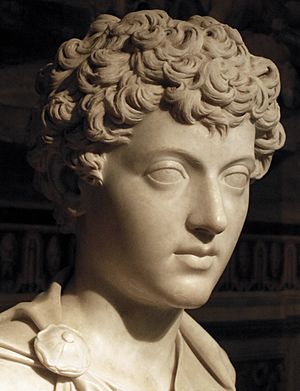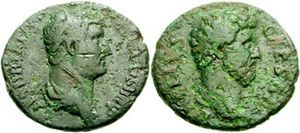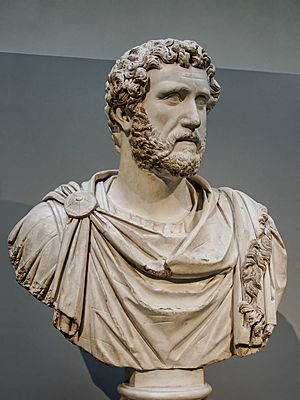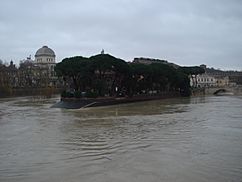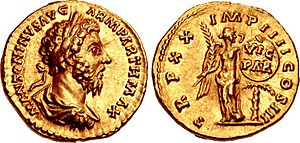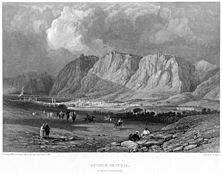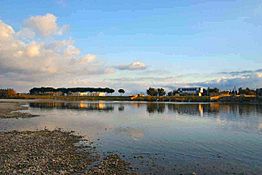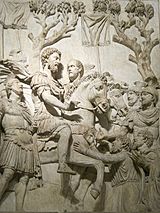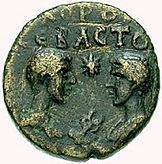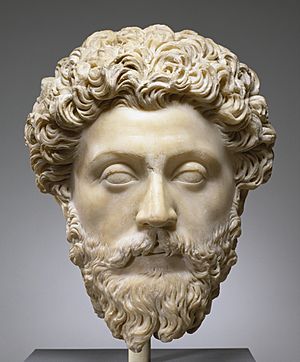Marcus Aurelius facts for kids
Quick facts for kids Marcus Aurelius |
|||||||||
|---|---|---|---|---|---|---|---|---|---|
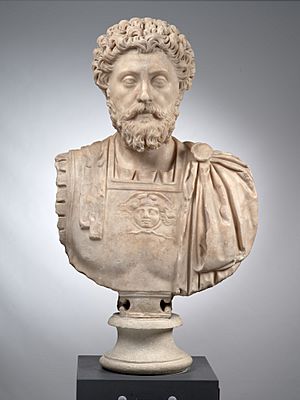
Marble bust, Musée Saint-Raymond
|
|||||||||
| Roman emperor | |||||||||
| Reign | 7 March 161 – 17 March 180 | ||||||||
| Predecessor | Antoninus Pius | ||||||||
| Successor | Commodus | ||||||||
| Co-emperor |
|
||||||||
| Born | 26 April 121 Rome, Italy |
||||||||
| Died | 17 March 180 (aged 58) Vindobona, Pannonia Superior or Sirmium, Pannonia Inferior |
||||||||
| Burial | Hadrian's Mausoleum | ||||||||
| Spouse | Faustina the Younger (m. 145; died 175) |
||||||||
| Issue Detail |
14, including Commodus, Marcus Annius Verus Caesar, Lucilla, Annia Galeria Aurelia Faustina, Fadilla, Annia Cornificia Faustina Minor, and Vibia Aurelia Sabina | ||||||||
|
|||||||||
| Dynasty | Nerva–Antonine | ||||||||
| Father |
|
||||||||
| Mother | Domitia Calvilla | ||||||||
|
Philosophy career |
|||||||||
|
Notable work
|
Meditations | ||||||||
| Era | Hellenistic philosophy | ||||||||
| Region | Western philosophy | ||||||||
| School | Stoicism | ||||||||
|
Main interests
|
Ethics | ||||||||
|
Notable ideas
|
Memento mori | ||||||||
|
Influences
|
|||||||||
|
Influenced
|
|||||||||
Marcus Aurelius Antoninus (born April 26, 121 AD – died March 17, 180 AD) was a Roman emperor and a Stoic philosopher. He ruled from 161 to 180 AD. He was the last of the "Five Good Emperors". This group of rulers was known for bringing peace and stability to the Roman Empire. This peaceful time was called the Pax Romana, which lasted from 27 BC to 180 AD. Marcus Aurelius also served as a Roman consul three times.
Marcus Aurelius was born in Rome during the reign of Emperor Hadrian. His father, Marcus Annius Verus, was a praetor (a high-ranking official). His mother was Domitia Calvilla. When Marcus was three, his father died. His mother and grandfather raised him.
In 138 AD, Emperor Hadrian adopted Marcus's uncle, Antoninus Pius, as his heir. Antoninus then adopted Marcus and Lucius Verus, another young relative. Hadrian died that year, and Antoninus became emperor. As the new heir, Marcus studied Greek and Latin with famous teachers like Herodes Atticus and Marcus Cornelius Fronto. In 145 AD, he married Antoninus's daughter, Faustina the Younger.
After Antoninus died in 161 AD, Marcus Aurelius became emperor. He shared power with his adoptive brother, Lucius Verus. During their rule, the Roman Empire faced many military challenges. They fought successfully against the Parthian Empire in the East. Marcus also defeated the Marcomanni, Quadi, and Sarmatian Iazyges in the Marcomannic Wars. These wars showed that Germanic tribes were becoming a big problem for the Empire.
A terrible sickness called the Antonine Plague broke out around 165 AD. It killed millions of people across the Roman Empire. Lucius Verus might have died from this plague in 169 AD.
Marcus Aurelius chose his own son, Commodus, to be his successor. This was unusual because emperors often adopted their heirs. The Column and Equestrian Statue of Marcus Aurelius still stand in Rome. They celebrate his military victories. Marcus's personal writings, called Meditations, are an important source for understanding ancient Stoic philosophy. Many people, from writers to leaders, have praised these writings for centuries.
Contents
Marcus Aurelius's Early Life
Marcus was born in Rome on April 26, 121 AD. His birth name was likely Marcus Annius Catilius Severus. When he was adopted by Antoninus as the heir, his name changed to Marcus Aelius Aurelius Verus Caesar. When he became emperor, he was known as Marcus Aurelius Antoninus Augustus.
His Family Background
Marcus's family came from both Roman and Spanish backgrounds. His father's family, the Annii, had Italian roots and became important in Rome. His great-grandfather was a senator, and his grandfather was made a patrician (a member of the noble class). Through his grandmother, Marcus was connected to the imperial family.
His mother, Domitia Lucilla Minor, was very wealthy. She owned large brick factories near Rome, which were very profitable. She also owned a villa on the Caelian hill in Rome, where Marcus was born and grew up. He called the Caelian hill "My Caelian."
Marcus's adoptive family, the Aurelii, had Italian and Gallic roots. His adoptive father, Antoninus Pius, came from a branch of this family in Roman Gaul.
Growing Up as a Young Roman
Marcus's sister, Annia Cornificia Faustina, was born around 122 or 123 AD. His father died in 124 AD, when Marcus was only three. Marcus was raised by his grandfather, Marcus Annius Verus (II). He also had help from his maternal great-grandfather, Lucius Catilius Severus. Marcus grew up in his parents' home on the Caelian Hill, a fancy part of Rome. He thanked his grandfather for teaching him "good character."
From a young age, Marcus enjoyed wrestling and boxing. He also learned to fight in armor. He joined the Salii, a group of priests dedicated to the god Mars. Marcus was educated at home, which was common for wealthy families. One of his teachers, Diognetus, introduced him to philosophy. In 132 AD, Marcus started living like a philosopher. He wore a simple Greek cloak and slept on the ground until his mother convinced him to use a bed.
Later, new tutors taught him Greek and Latin. Marcus thanked his Greek teacher, Alexander of Cotiaeum, for helping him with his writing style.
Becoming Hadrian's Heir
In 136 AD, Emperor Hadrian almost died. He chose Lucius Ceionius Commodus, who was supposed to marry Marcus's sister, as his successor. Hadrian's goal was to eventually make Marcus emperor, but Marcus was too young at the time. Lucius Aelius Caesar, as he was called, had poor health and died in early 138 AD.
On January 24, 138 AD, Hadrian chose Marcus's aunt's husband, Antoninus, as his new successor. Hadrian asked Antoninus to adopt both Marcus and Lucius Commodus (Lucius Aelius's son). Marcus became M. Aelius Aurelius Verus. Marcus was sad about this news, not happy. He reluctantly moved from his mother's house to Hadrian's imperial home.
Hadrian also asked the Senate to allow Marcus to become a quaestor (a financial official) before he was 24. The Senate agreed. Marcus's adoption changed his career path. He would now be trained to rule the state. His biographer said that Marcus remained humble and careful with his money, even after becoming heir.
Hadrian died on July 10, 138 AD. Antoninus became emperor peacefully. Antoninus kept Hadrian's officials in their jobs and respected the Senate. For his good behavior, Antoninus was given the name 'Pius'.
Marcus as Heir to Antoninus Pius
After Hadrian's death, Antoninus asked Marcus to change his marriage plans. Marcus was supposed to marry Ceionia Fabia. Instead, he would marry Faustina the Younger, Antoninus's daughter. Marcus agreed.
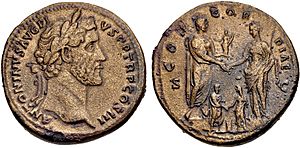
In 140 AD, Marcus became consul with Antoninus. He was also made a leader of the knights. As the heir, Marcus became princeps iuventutis, the head of the equestrian order. He took the name Marcus Aelius Aurelius Verus Caesar. Marcus later reminded himself not to take this title too seriously. He joined all the important priestly groups.
Antoninus wanted Marcus to live in the imperial palace and act like an heir. As quaestor, Marcus had little real work. He would read imperial letters to the Senate when Antoninus was away. He complained to his tutor, Marcus Cornelius Fronto, about the amount of paperwork. His biographer said he was being "fitted for ruling the state." He also had to give speeches to the Senate, so public speaking was very important.
On January 1, 145 AD, Marcus became consul for a second time. Fronto told him to get enough sleep so he could speak well in the Senate. Marcus had complained about being sick. He was never very strong, but he always did his duty despite his illnesses. In April 145 AD, Marcus married Faustina. Coins were made with their faces on them.
Learning and Philosophy
After becoming an adult in 136 AD, Marcus began training in public speaking. He had three Greek tutors and one Latin tutor, Marcus Cornelius Fronto. Fronto and Herodes Atticus were the most respected speakers of their time. Most of his tutors were Greek, showing how important the Greek language was in Rome. Marcus later wrote his deepest thoughts in Greek in his Meditations.
Atticus was a very rich Athenian. He was known for getting angry easily and disliked Stoicism. Despite Atticus's views, Marcus later became a Stoic.
Fronto was highly respected for his mastery of Latin. Many letters between Fronto and Marcus still exist. They were very close friends. Marcus spent time with Fronto's family. He wrote to Fronto on his birthday, saying he loved him like himself. Fronto was often sick, and Marcus wished his pain could be on himself.
Fronto warned Marcus against studying philosophy too much. He thought it was better not to study it at all than to only learn a little. Fronto disliked philosophers and Marcus's meetings with them. He thought Marcus turned to philosophy to escape boring schoolwork. Marcus stayed in touch with Fronto but ignored his warnings about philosophy.
Quintus Junius Rusticus had the strongest influence on Marcus's philosophy. Fronto said Rusticus "wooed Marcus away" from public speaking. Rusticus was older than Fronto and Marcus. He was connected to the "Stoic Opposition" against bad emperors. Marcus thanked Rusticus for teaching him not to get too excited about fancy speeches or writing.
Family Life: Births and Deaths
On November 30, 147 AD, Faustina gave birth to a girl named Domitia Faustina. She was the first of at least thirteen children Marcus and Faustina would have. The next day, Antoninus gave Marcus special powers, including authority over the armies. Marcus's powers were renewed each year. Marcus's letters show that Domitia was a sickly baby. She died in 151 AD.
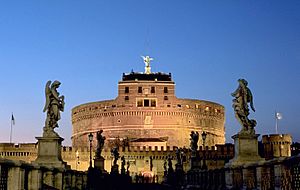
In 149 AD, Faustina gave birth to twin sons. Coins were made to celebrate this happy event. But the twins did not live long. Before the end of the year, coins showed only a girl and one boy. Then, only the girl. The babies were buried in the Mausoleum of Hadrian. Marcus tried to stay strong, quoting from the Iliad to help with his sorrow.
Another daughter, Annia Aurelia Galeria Lucilla, was born on March 7, 150 AD. Marcus's mother, Domitia Lucilla, died sometime between 155 and 161 AD. Faustina likely had another daughter in 151 AD, Annia Galeria Aurelia Faustina. A son, Tiberius Aelius Antoninus, was born in 152 AD but died young. By 158 AD, another child had died. In 159 and 160 AD, Faustina gave birth to two more daughters, Fadilla and Cornificia.
Antoninus Pius's Final Years
Lucius Verus began his political career in 153 AD. He became consul in 154 AD and again with Marcus in 161 AD. Lucius had a different personality from Marcus. He enjoyed sports, especially hunting and wrestling. He also liked circus games and gladiator fights.
In 156 AD, Antoninus turned 70. He was getting weaker. Marcus took on more and more of the emperor's duties. In 160 AD, Marcus and Lucius were named consuls for the next year. Antoninus was likely already ill.
Two days before his death, Antoninus was at his family home near Rome. He ate a lot of cheese and got a fever. On March 7, 161 AD, he called his advisors and passed the empire to Marcus. His last word was "aequanimitas" (calmness). He then died. His reign was the longest since Augustus.
Marcus Aurelius Becomes Emperor
Sharing Power with Lucius Verus
After Antoninus died in 161 AD, Marcus was the main ruler. The Senate quickly offered him the title of Augustus and imperator (emperor). He would also become pontifex maximus, the chief priest. Marcus showed some hesitation, perhaps because he preferred a quiet, philosophical life. But his Stoic training taught him it was his duty.
Marcus believed he should follow Hadrian's plan for succession. So, even though the Senate wanted to make Marcus sole emperor, he refused unless Lucius received equal power. The Senate agreed. Marcus became Imperator Caesar Marcus Aurelius Antoninus Augustus. Lucius became Imperator Caesar Lucius Aurelius Verus Augustus. This was the first time Rome had two emperors ruling at the same time.
Even with equal titles, Marcus had more authority than Lucius. Marcus had been consul more times and had shared Antoninus's rule. He was also the chief priest. It was clear to everyone that Marcus was the more senior emperor.
After their Senate approval, the emperors went to the camp of the Praetorian Guard. Lucius spoke to the soldiers, who cheered for both emperors. Lucius promised the troops a special gift, twice as large as previous ones. This gift was a lot of money, equal to several years' pay. In return, the soldiers swore to protect the emperors. This ceremony was good insurance against future military problems. Marcus also changed the value of Roman money, slightly reducing the silver in the denarius.
Antoninus's funeral was very grand. His body was likely burned on a pyre, and his spirit was seen as rising to the gods. Marcus and Lucius asked the Senate to declare their father a god. The Senate agreed. Antoninus's remains were placed in Hadrian's Mausoleum, next to Marcus's children and Hadrian.
Antoninus's wealth went to Faustina, as he wished. Faustina was pregnant when Marcus became emperor. On August 31, she gave birth to twin sons, T. Aurelius Fulvus Antoninus and Lucius Aurelius Commodus. The births were celebrated on imperial coins.
Early Years of Joint Rule
Soon after becoming emperor, Marcus's eleven-year-old daughter, Annia Lucilla, was engaged to Lucius. New programs were created to help poor children. Marcus and Lucius were popular with the Roman people because they acted humbly. They allowed free speech, and people could criticize them without punishment.
Marcus replaced some important officials. He brought in people who were good at handling military crises. His former tutor, Lucius Volusius Maecianus, was made a senator and put in charge of the treasury. Fronto's son-in-law, Gaius Aufidius Victorinus, became governor of Upper Germany.
Fronto was very proud of his students. He wrote to Marcus, saying that his hope for Marcus's excellence had come true. Fronto visited Marcus, but not Lucius, as Lucius's interests were "on a lower level." Lucius asked Fronto to settle a dispute about actors. Marcus told Fronto about his reading and his family. His daughters were in Rome because the country air was too cold for them. Marcus asked Fronto for uplifting reading material to help with his worries.
Marcus's early rule went smoothly. He could focus on philosophy and being popular. But soon, he would face many challenges, ending the "happy times" that coins had celebrated.
In late 161 or early 162 AD, the Tiber flooded much of Rome. Marcus and Lucius personally helped with the crisis. In other times of hunger, the emperors provided food to Italian communities from Rome's storehouses.
Fronto continued to write to Marcus. He felt that Marcus's public duties made his lessons even more important. Fronto reminded Marcus that even if he became as wise as a philosopher, he still had to act like an emperor.
The early days of Marcus's reign were very happy for Fronto. Marcus was loved by the people, was a good emperor, and was a good student. Marcus showed great speaking skills after an earthquake. Fronto was very pleased.
War with Parthia (161–166 AD)
Before Antoninus died, he spoke of foreign kings who had wronged Rome. One of them, Vologases IV of Parthia, attacked in late 161 AD. Vologases took over the Kingdom of Armenia, which was a Roman client state. He put his own king, Pacorus, on the throne.
The governor of Cappadocia, Marcus Sedatius Severianus, led a Roman legion into Armenia. But the Parthian general Chosrhoes trapped his army. The Roman legion was destroyed in just three days.
There were also threats on other borders, in Britain and Germany. Marcus was not prepared for war. Antoninus had not given him much military experience.
More bad news arrived: the Syrian governor's army had also been defeated by the Parthians. Reinforcements were sent to the Parthian border. Three full legions were sent from other parts of the empire. The northern borders were left weaker. Governors were told to avoid conflict if possible. Marcus's cousin, M. Annius Libo, was sent to replace the Syrian governor. He was young and lacked military experience. Marcus chose him for his reliability, not his talent.
Marcus took a short holiday, but he was too worried to relax. He wrote to Fronto that he had duties that he could not avoid. He had rested, but his devotion to duty was too demanding.
Fronto sent Marcus reading material and a long letter about the Parthian war. He reminded Marcus that Rome had faced setbacks before but always won in the end.
In late 161 or early 162 AD, it was decided that Lucius should lead the Parthian war in person. He was stronger and healthier than Marcus, and better suited for military action. Lucius's biographer also suggested it was to help Lucius improve his behavior. The Senate agreed, and Lucius left in the summer of 162 AD. Marcus stayed in Rome because the city needed an emperor.
Lucius spent most of the campaign in Antioch. Critics said Lucius lived a luxurious life, gambling and enjoying actors. Libo died early in the war.
During the war, around 163 or 164 AD, Lucius traveled to Ephesus to marry Marcus's daughter, Lucilla. Marcus moved up the wedding date, perhaps because he heard about Lucius's mistress. Lucilla was not yet fifteen. She was accompanied by her mother Faustina and Lucius's uncle, M. Vettulenus Civica Barbarus. Marcus may have wanted Civica to watch over Lucius. Marcus only went as far as Brundisium before returning to Rome.
The Armenian capital, Artaxata, was captured in 163 AD. Lucius took the title Armeniacus (victor in Armenia), even though he hadn't fought. Marcus waited until the next year to accept the title. A new capital was built in Armenia, and a new king, Gaius Julius Sohaemus, was installed.
In 163 AD, the Parthians also interfered in Osroene, a Roman client state. Roman forces moved to take back control. By the end of 163 AD, Roman forces had taken towns on the northern bank of the Euphrates. Other Roman forces moved from Armenia into Osroene.
In 165 AD, Roman forces moved into Mesopotamia. Edessa was re-occupied, and its king was put back on the throne. The Parthians retreated to Nisibis, which was also captured. The Parthian army scattered. Another Roman force, led by Avidius Cassius, moved down the Euphrates and fought a major battle.
By the end of the year, Cassius's army reached the main cities of Mesopotamia: Seleucia and Ctesiphon. Ctesiphon was captured and its palace burned. The people of Seleucia opened their gates to the Romans, but the city was still sacked. This hurt Lucius's reputation.
Cassius's army, despite facing supply shortages and a plague, returned safely to Roman territory. Lucius took the title Parthicus Maximus (greatest victor over the Parthians). Both emperors were hailed as imperatores again. Cassius's army returned to the field in 166 AD, crossing into Media. Lucius took the title 'Medicus' (victor in Media). Marcus also took the Parthicus Maximus title. On October 12, 166 AD, Marcus named two of his sons, Annius and Commodus, as his heirs.
Wars with Germanic Tribes (166–180 AD)
In the early 160s, the northern Roman borders were in trouble. Germanic tribes and other nomadic people started raiding along the border, especially into Gaul and across the Danube River. This was probably because tribes further east were attacking them. A first invasion by the Chatti in Germany was stopped in 162 AD.
Much more dangerous was the invasion of 166 AD. The Marcomanni from Bohemia, who had been Roman allies, crossed the Danube with other Germanic tribes. Soon after, the Sarmatian Iazyges attacked between the Danube and Theiss rivers.
The Costoboci from the Carpathian area invaded Moesia, Macedonia, and Greece. After a long fight, Marcus managed to push back the invaders. Many Germanic tribes settled in border regions like Dacia, Pannonia, Germany, and even Italy. This was not new, but this time so many settlers came that two new provinces were planned on the Danube's left bank: Sarmatia and Marcomannia. Some Germanic tribes who settled in Ravenna revolted and took over the city. Because of this, Marcus decided not to bring more "barbarians" into Italy.
Legal and Government Work
Like many emperors, Marcus spent most of his time dealing with legal matters. He handled petitions and heard disputes. Unlike many before him, he was already skilled in government when he became emperor. He cared deeply about making good laws. Legal experts called him "an emperor most skilled in the law" and "a most careful and just emperor." He was especially interested in laws about freeing slaves, protecting orphans and minors, and choosing city council members.
Marcus showed great respect for the Roman Senate. He often asked them for permission to spend money, even though he didn't have to as the ruler. In one speech, Marcus reminded the Senate that the imperial palace was not truly his, but theirs. In 168 AD, he increased the silver in the denarius coin. However, two years later, he changed it back because of the military problems the empire faced.
Trade with China and the Plague
In 166 AD, a Roman traveler visited the Han court in China. He claimed to be an ambassador from "Andun," the ruler of Daqin (which could be Marcus Aurelius or Antoninus Pius). Roman glass has been found in China, and Roman gold medallions from Marcus's time have been found in Vietnam. This suggests trade between Rome and the Far East.
The Antonine Plague began in Mesopotamia in 165 or 166 AD, after Lucius's war against the Parthians. It might have continued into the reign of Commodus. Galen, a doctor in Rome, described the symptoms as fever, diarrhea, sore throat, and skin rashes. It is believed the plague was smallpox. Some historians think the plagues in China during this time might be connected to the Roman plague. The disease caused great damage to Roman trade in the Indian Ocean and Southeast Asia.
Death and Successor (180 AD)

Marcus Aurelius died on March 17, 180 AD, at age 58. He died in his military camp, either in Vindobona (modern Vienna) or near Sirmium (modern Sremska Mitrovica). The cause of his death is unknown. He was immediately declared a god, and his ashes were brought to Rome. They were placed in Hadrian's mausoleum (now Castel Sant'Angelo). Some scholars believe his death marked the end of the Pax Romana.

Marcus was succeeded by his son, Commodus. Marcus had named Commodus his heir in 166 AD and they had ruled together since 177 AD. It was rare for a biological son to succeed his father as emperor. Historians have criticized this choice because Commodus was known for his strange behavior and lack of leadership skills.
One historian, Dio, wrote that Marcus remained the same person from his first days as an advisor to Antoninus until his death as emperor.
Marcus Aurelius and Christians
In the early centuries of Christianity, local Roman officials were mostly responsible for persecuting Christians. Emperors in the second century often saw Christianity as a local issue. However, the number of persecutions seemed to increase during Marcus Aurelius's reign. It's not clear how much the emperor himself ordered or knew about these persecutions. Early Christians did not claim he persecuted them. One Christian writer even called Marcus a "protector of Christians."
Marriage and Children
Marcus and his cousin-wife Faustina the Younger had at least 14 children during their 30-year marriage. This included two sets of twins. One son and four daughters lived longer than their father. Their children included:
- Domitia Faustina (147–151 AD)
- Titus Aelius Antoninus (born 149 AD)
- Titus Aelius Aurelius (born 149 AD)
- Annia Aurelia Galeria Lucilla (150–182 AD), who married Lucius Verus
- Annia Galeria Aurelia Faustina (born 151 AD)
- Tiberius Aelius Antoninus (born 152 AD, died before 156 AD)
- An unknown child (died before 158 AD)
- Annia Aurelia Fadilla (born 159 AD)
- Annia Cornificia Faustina Minor (born 160 AD)
- Titus Aurelius Fulvus Antoninus (161–165 AD), twin brother of Commodus
- Lucius Aurelius Commodus Antoninus (Commodus) (161–192 AD), twin brother of Titus Aurelius Fulvus Antoninus, who later became emperor
- Marcus Annius Verus Caesar (162–169 AD)
- Hadrianus
- Vibia Aurelia Sabina (170–died before 217 AD)
Nerva–Antonine family tree
|
|||||||||||||||||||||||||||||||||||||||||||||||||||||||||||||||||||||||||||||||||||||||||||||||||||||||||||||||||||||||||||||||||||||||||||||||||||||||||||||||||||||||||||||||||||||||||||||||||||||||||||||||||||||||||||||||||||||||||||||||||||||||||||||||||||||||||||||||||||||||||||||||||||||||||||||||||||||||||||||||||||||||||||||||||||||||||||||||||||||||||||||||||||||||||||||||||||||||||||||||||||||||||||||||||||||||||||||||||||||||||||||||||||||||||||||||||||||||||||||||||||||||||||||||||||||||||||||||||||||||||||||||||||||||||||||||||||||||||||||||||||||||||||||||||||||||||||||||||||||||||||||||||||||||||||||||||||||||||||||||||||||||||||||||||||||||||||||||||||||||||||||||||||||||||||||||||||||||||||||||||||||||||||||||||||||||||||||||||||||||||||||||||||||||||||||||||||||||||||||||||||||||||||||||||||||||||||||||||||||||||||||||||||||||||||||||||||||||||||||||||||||||||||||||||||||||||||||||||||||||||||||||||||||||||||||||||||||||||||||||||||||||||||||||||||||||||||||||||||||||
|
|||||||||||||||||||||||||||||||||||||||||||||||||||||||||||||||||||||||||||||||||||||||||||||||||||||||||||||||||||||||||||||||||||||||||||||||||||||||||||||||||||||||||||||||||||||||||||||||||||||||||||||||||||||||||||||||||||||||||||||||||||||||||||||||||||||||||||||||||||||||||||||||||||||||||||||||||||||||||||||||||||||||||||||||||||||||||||||||||||||||||||||||||||||||||||||||||||||||||||||||||||||||||||||||||||||||||||||||||||||||||||||||||||||||||||||||||||||||||||||||||||||||||||||||||||||||||||||||||||||||||||||||||||||||||||||||||||||||||||||||||||||||||||||||||||||||||||||||||||||||||||||||||||||||||||||||||||||||||||||||||||||||||||||||||||||||||||||||||||||||||||||||||||||||||||||||||||||||||||||||||||||||||||||||||||||||||||||||||||||||||||||||||||||||||||||||||||||||||||||||||||||||||||||||||||||||||||||||||||||||||||||||||||||||||||||||||||||||||||||||||||||||||||||||||||||||||||||||||||||||||||||||||||||||||||||||||||||||||||||||||||||||||||||||||||||||||||||||||||||||
| Notes:
Except where otherwise noted, the notes below indicate that an individual's parentage is as shown in the above family tree. |
|||||||||||||||||||||||||||||||||||||||||||||||||||||||||||||||||||||||||||||||||||||||||||||||||||||||||||||||||||||||||||||||||||||||||||||||||||||||||||||||||||||||||||||||||||||||||||||||||||||||||||||||||||||||||||||||||||||||||||||||||||||||||||||||||||||||||||||||||||||||||||||||||||||||||||||||||||||||||||||||||||||||||||||||||||||||||||||||||||||||||||||||||||||||||||||||||||||||||||||||||||||||||||||||||||||||||||||||||||||||||||||||||||||||||||||||||||||||||||||||||||||||||||||||||||||||||||||||||||||||||||||||||||||||||||||||||||||||||||||||||||||||||||||||||||||||||||||||||||||||||||||||||||||||||||||||||||||||||||||||||||||||||||||||||||||||||||||||||||||||||||||||||||||||||||||||||||||||||||||||||||||||||||||||||||||||||||||||||||||||||||||||||||||||||||||||||||||||||||||||||||||||||||||||||||||||||||||||||||||||||||||||||||||||||||||||||||||||||||||||||||||||||||||||||||||||||||||||||||||||||||||||||||||||||||||||||||||||||||||||||||||||||||||||||||||||||||||||||||||||
References:
|
|||||||||||||||||||||||||||||||||||||||||||||||||||||||||||||||||||||||||||||||||||||||||||||||||||||||||||||||||||||||||||||||||||||||||||||||||||||||||||||||||||||||||||||||||||||||||||||||||||||||||||||||||||||||||||||||||||||||||||||||||||||||||||||||||||||||||||||||||||||||||||||||||||||||||||||||||||||||||||||||||||||||||||||||||||||||||||||||||||||||||||||||||||||||||||||||||||||||||||||||||||||||||||||||||||||||||||||||||||||||||||||||||||||||||||||||||||||||||||||||||||||||||||||||||||||||||||||||||||||||||||||||||||||||||||||||||||||||||||||||||||||||||||||||||||||||||||||||||||||||||||||||||||||||||||||||||||||||||||||||||||||||||||||||||||||||||||||||||||||||||||||||||||||||||||||||||||||||||||||||||||||||||||||||||||||||||||||||||||||||||||||||||||||||||||||||||||||||||||||||||||||||||||||||||||||||||||||||||||||||||||||||||||||||||||||||||||||||||||||||||||||||||||||||||||||||||||||||||||||||||||||||||||||||||||||||||||||||||||||||||||||||||||||||||||||||||||||||||||||||
Marcus Aurelius's Writings
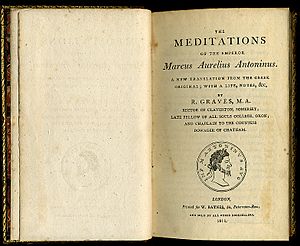
Between 170 and 180 AD, while on military campaigns, Marcus wrote his Meditations. He wrote it in Greek as a guide for himself and to help him improve. The original title is unknown; "Meditations" and "To Himself" were added later. His writings show a logical mind and reflect Stoic philosophy. Meditations is still seen as a great example of leadership based on service and duty. Many famous people, from queens to presidents, have admired this book. It is considered one of the greatest works of philosophy.
It's not known how widely Marcus's writings were shared after his death. Some old texts mention his wise sayings. The first known quotes from Meditations and its first mention by name are from the 10th century. The book was first published in 1558. The oldest complete copy of the manuscript is in the Vatican Library and dates to the 14th century.
Equestrian Statue of Marcus Aurelius
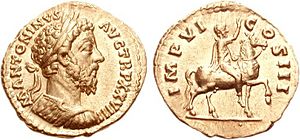
The Equestrian Statue of Marcus Aurelius in Rome is the only Roman equestrian (on horseback) statue that still exists today. It survived because people in the Middle Ages mistakenly thought it was a statue of the Christian emperor Constantine the Great. So, it was not destroyed like statues of pagan figures.

Made of bronze around 175 AD, the statue is about 11.6 feet (3.5 meters) tall. It is now in the Capitoline Museums in Rome. The emperor's hand is held out, showing mercy to a defeated enemy. His tired face, caused by the stress of constant battles, shows a change from the usual calm look of classical sculpture.
Column of Marcus Aurelius
Marcus's victory column in Rome was built to celebrate his victory over the Sarmatians and Germanic tribes in 176 AD. It was finished in 193 AD. A spiral of carved reliefs wraps around the column, showing scenes from his military campaigns. A statue of Marcus once stood on top but disappeared during the Middle Ages. In 1589, a statue of Saint Paul was placed there instead. Scholars often compare Marcus's column to Trajan's Column because they are similar in style and both show military victories.
Marcus Aurelius's Legacy
During his lifetime, Marcus gained a reputation as a "philosopher king." This title stayed with him after his death. Historians and Christian writers called him "the philosopher." Some even said he was "more philanthropic and philosophic" than other emperors.
See also
 In Spanish: Marco Aurelio para niños
In Spanish: Marco Aurelio para niños


